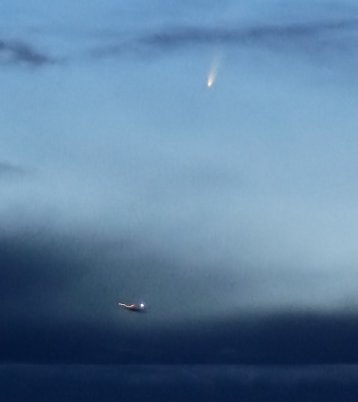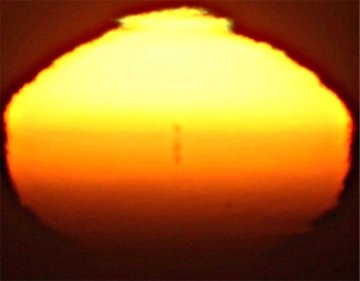 Did you sleep through the auroras of Dec. 14th? Next time get a wake-up call: Spaceweather PHONE.
Did you sleep through the auroras of Dec. 14th? Next time get a wake-up call: Spaceweather PHONE.
COMET MCNAUGHT: When the sun sets tonight, go outside immediately and look west. You may see the brightest comet in thirty years hanging just above the horizon.
"What a beautiful sight! Last night, comet McNaught (C/2006 P1) was easily visible to the naked eye and even more stunning in 10x50 binoculars," reports Chris Cook of Cape Cod, Massachusetts. "The star-like nucleus glowed with a golden hue as a broad elegant tail extended more than one degree: image."
In Reykjavik, Iceland, photographer Islandia Geomatics caught the comet chasing an airplane:

Photo details: Sony DSC-H5 camera, 34.9 mm lens, f/3.5, ISO 320, 0.125 s.
"The residence of the President of Iceland is also visible at the bottom of the picture," he points out.
Comet McNaught is plunging toward the sun, and the heat is causing it to brighten dramatically. A few days ago, it was barely visible in evening twilight, but now it pops into view while the sky is still glowing blue. Only Venus is brighter.
If you have trouble finding the comet (because of clouds or glare) scan the horizon with binoculars. Once located, it's easy to follow. "I am 66 years old but I don't think I have ever seen such a comic-book comet. Fantastic!" reports Jon Baily of Aberdeenshire, Scotland. "I shall never forget this view!"
Comet McNaught Photo Gallery
[finder chart] [ephemeris] [3D orbit]
WHILE YOU'RE WAITING... for Comet McNaught to emerge from the twilight, keep an eye on the sun. Strange things can happen in the moments before sunset. On Jan. 7th, Mila Zinkova of San Francisco took this picture overlooking the Pacific Ocean:

Photo details: Canon XTI, 500 mm mirror lens, f/8, 1/4000 seconds
Temperature inversions in the air just above the sea surface distorted the shape of the sun and stretched sunspot 930 into a long vertical smear. "It was an amazing example of a superior mirage," says Zinkova.
WARNING: Zinkova cautions first-time sun photographers, "do not look through the camera's view finder. Even a low-hanging sun can be dangerously bright, and everybody should remember that they could damage their eyes." Suggestion: Use the camera's LCD screen to center the sun in the field of view.

